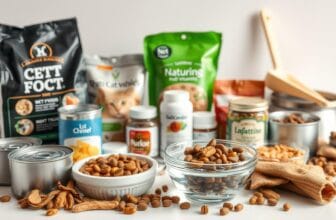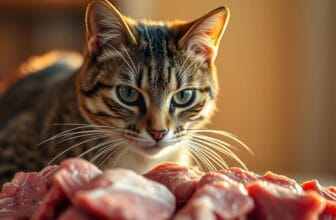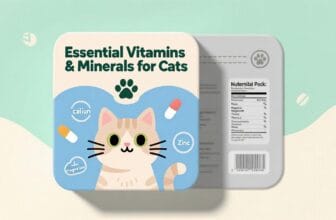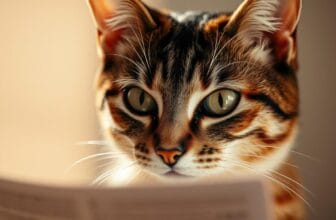
Table of Contents
Ever thought about how feeding your cat could affect their health and happiness? Feeding cats isn’t just about putting food in a bowl. It’s about understanding their specific needs and lifestyle.
Cats have a unique digestive system. It’s different from other pets. Their stomachs trigger hunger after 8 to 10 hours without food. This makes it key to know the best way to feed them.
There are two main ways to feed cats: free feeding and scheduled feeding. Each has its own benefits and downsides. These can greatly affect your cat’s health, weight, and behavior.
This guide will dive deep into these feeding methods. We’ll help you choose the best one for your cat’s health and happiness. We’ll cover everything from their nutritional needs to the best feeding strategy.
Understanding Cat Feeding Methods
Choosing the right cat feeding techniques is key to your cat’s health and happiness. Cat owners must decide between different feeding methods. This choice affects your pet’s nutrition and well-being.
Cats have special dietary needs that need careful thought. There are two main feeding approaches: free feeding and scheduled feeding. Each has its own benefits and challenges for pet owners.
What Makes Each Feeding Method Unique
Cat feeding techniques differ in several important ways:
- Availability of food all day
- How food portions are controlled
- Each cat’s metabolism
- Owner’s lifestyle and the cat’s activity level
The Impact on Cat Health and Behavior
“Understanding your cat’s nutritional needs is the first step to optimal health.” – Veterinary Nutrition Expert
Different feeding methods can greatly affect your cat’s:
- Weight management
- Digestive health
- Eating habits
- Mental stimulation
Factors to Consider When Choosing a Method
Your cat’s unique needs should guide your choice. Think about your cat’s age, health, and daily activities. This will help you decide between free feeding and scheduled meals.
Pro tip: Talk to your vet to find the best feeding method for your cat.
The Science Behind Cat Eating Habits
To understand your cat’s eating habits, you need to know about their biology. Cats are meat-eaters with a body made for high-protein diets. Their eating ways come from their evolution, which is different from other pets.
Cats have a special way of breaking down food. They need more protein than many other pets because of this. This is why they like to eat small meals often during the day.
- Cats evolved as hunters with multiple small prey captures
- Their digestive system is optimized for protein breakdown
- Metabolic rates vary based on age, weight, and activity level
Your cat’s eating habits come from their wild ancestors. In the wild, they hunted many small animals all day. This is why they like to eat small meals often at home.
| Metabolic Characteristic | Impact on Eating Behavior |
|---|---|
| High Protein Requirements | Prefer meat-based diets |
| Fast Metabolism | Need frequent smaller meals |
| Low Carbohydrate Tolerance | Limited ability to process grains |
Knowing about cat eating habits can help you choose better food and feeding times for your cat.
What is Free Feeding Cats
Free feeding is a way to feed your cat that lets them eat all day. It’s like how they eat in the wild, with many small meals. You set up a free feeding station so your cat can always find food.
This method is different from regular meal times. It lets cats eat as much as they want. But, it needs the right food and careful watching to avoid health problems.
How Free Feeding Works
You leave dry food out all day in a special bowl. Cats can eat whenever they want. This can help them feel less stressed about food and keep their metabolism steady.
- Food is always accessible
- Cats eat small portions throughout the day
- Mimics natural hunting and eating patterns
Types of Food Suitable for Free Feeding
Not all foods are good for free feeding. Dry kibble is best because it lasts longer and doesn’t spoil easily.
| Food Type | Free Feeding Suitability |
|---|---|
| Dry Kibble | Excellent |
| Wet Food | Not Recommended |
| Semi-Moist Food | Limited |
Setting Up a Free Feeding Station
Make a good free feeding spot in a quiet, clean place away from the litter box. Use a wide, shallow bowl to keep food fresh and prevent whisker problems.
- Select a stable, clean location
- Choose a wide, shallow food bowl
- Monitor food quantity and freshness
- Clean the feeding area regularly
Remember, free feeding is easy but you must watch your cat’s weight. Adjust food amounts to avoid obesity.
Benefits of Free Feeding

Free feeding is great for cat owners who want easy and flexible feeding options. It changes how you feed your cat, especially if you’re always busy.
Cats are natural grazers, eating small amounts all day. This fits their instinctive eating habits well. It also makes mealtime less stressful for them.
- Supports cats with irregular appetite patterns
- Reduces anxiety around food availability
- Accommodates unpredictable owner schedules
- Helps maintain consistent energy levels
Free feeding is also good for cats with health issues. Underweight cats or those with metabolic challenges need food all the time to stay healthy and at a good weight.
“Free feeding allows cats to eat when they’re naturally hungry, mimicking their wild eating behaviors.” – Veterinary Nutrition Expert
Free feeding is not just about convenience. It also makes mealtime stress-free. This is good for your cat’s mind and body, making it a popular choice for many owners.
Drawbacks and Risks of Free Feeding
Free feeding might seem easy, but it has big health risks for your cat. Knowing the dangers of free feeding helps you choose better for your cat’s diet.
Weight Management Challenges
Cat overeating is a big problem with free feeding. Cats eat too much when food is always there. This can cause them to gain weight fast and get obese.
Being overweight can lead to serious health issues. These include diabetes, joint problems, and heart disease.
Food Safety Concerns
Free feeding can make food go bad quickly. Wet cat food is especially prone to bacteria and spoilage. Cats can get sick from eating old food.
Potential Behavioral Problems
Free feeding messes with your cat’s natural eating habits. It can cause behavioral issues. Cats might start to guard their food or lose interest in eating.
They might also get anxious about when they’ll eat next. This can make mealtime less fun for them.
Knowing these risks helps you pick a better way to feed your cat.
Understanding Scheduled Feeding

Scheduled feeding is a smart way to manage your cat’s diet. It involves setting specific times for meals. This method helps you control how much food your cat eats and watch their eating habits closely.
Using a meal plan has many benefits for cat owners. It creates a routine that helps your cat’s digestion and overall health. This routine is key for your cat’s well-being.
- Precise portion control for optimal nutrition
- Easy tracking of food intake
- Better weight management
- Opportunity to monitor health changes
Cats usually do best with 2-3 meals a day. The best feeding schedule depends on several things:
- Age of the cat
- Activity level
- Health conditions
- Specific dietary needs
| Cat Age Group | Recommended Meals per Day | Portion Size |
|---|---|---|
| Kittens (up to 6 months) | 3-4 meals | Small, frequent portions |
| Adult Cats (6 months – 7 years) | 2-3 meals | Balanced, measured portions |
| Senior Cats (7+ years) | 2 meals | Specialized senior cat portions |
Timed feeding lets you watch your cat’s hunger and spot health problems early. By sticking to a meal plan, you give your cat a balanced diet and a structured eating schedule.
Advantages of Scheduled Feeding Times
Setting up a controlled feeding schedule can change your cat’s life for the better. It’s not just about food. It brings structure, predictability, and a way to check on your pet’s health.
Feeding your cat on a schedule has many benefits. It helps you understand their health and behavior better.
Portion Control Benefits
Feeding your cat at set times helps manage their diet. You can:
- Measure exact food quantities
- Prevent overeating
- Manage weight effectively
- Reduce risk of obesity
Monitoring Health and Appetite
Regular meals let you watch your cat’s eating habits closely. Changes in appetite can signal potential health issues. This makes mealtime a key way to check on your cat’s health.
Creating Routine and Structure
Cats like knowing what to expect. A regular mealtime routine reduces stress and anxiety. It’s great for homes with many pets or where things often change.
“A structured feeding schedule is like a daily rhythm that keeps your cat feeling secure and balanced.”
Special Considerations for Multiple Cat Households

Feeding multiple cats can be tough for pet owners. Cat food competition often leads to tension in homes with many cats. Each cat has its own nutritional needs and eating habits that need careful handling.
To manage feeding multiple cats, you must develop strategies to avoid conflicts and ensure each cat gets the right food. Dominant cats can take over food, leaving others hungry or stressed.
- Create separate feeding stations
- Use microchip-activated feeders
- Monitor portion sizes for each cat
- Establish consistent feeding schedules
“Understanding each cat’s individual needs is key to successful multi-cat household feeding strategies.” – Veterinary Nutrition Expert
To reduce cat food competition, consider these practical solutions:
| Feeding Strategy | Benefits | Considerations |
|---|---|---|
| Elevated Feeding Stations | Reduces territorial disputes | Requires multiple elevated spaces |
| Microchip Feeders | Prevents food stealing | Higher initial cost |
| Scheduled Feeding Times | Establishes routine | Requires consistent timing |
Pro tip: Observe your cats’ interactions during mealtime to understand their unique dynamics and adjust your feeding strategy accordingly.
Feeding Methods for Different Life Stages
Your cat’s nutritional needs change a lot as they grow. It’s important to know about cat life stage nutrition. This helps keep your pet healthy and full of energy. Feeding them right for their age is key.
Cats go through big changes from being kittens to being seniors. Each stage needs a special diet and feeding method.
Kitten Feeding Guidelines
Kittens need lots of nutrients to grow fast. They should eat foods high in protein and calories. This helps them develop well.
- Feed kittens 3-4 small meals daily
- Choose kitten-specific formulas with higher protein content
- Ensure constant access to fresh water
Adult Cat Requirements
Adult cats need a balanced diet to stay healthy. They should eat the right amount and quality food. This helps them keep a good weight.
| Age Range | Feeding Frequency | Caloric Needs |
|---|---|---|
| 1-7 years | 2 meals daily | 250-300 calories |
| Active cats | 2-3 meals daily | 300-350 calories |
Senior Cat Nutrition
Older cats need special diets because of health issues. They have lower metabolism and may have medical problems. So, their food needs careful management.
- Lower calorie intake
- Enhanced digestibility
- Supplements for joint health
“Nutrition is the foundation of health at every life stage,” says veterinary nutritionist Dr. Karen Becker.
Changing your cat’s diet to fit their life stage is important. It helps them live longer and better.
Food Safety and Storage Tips
Keeping your cat’s food clean is key to their health. Knowing how to store food right can stop health problems. It also makes sure your cat eats fresh, healthy meals.
Different cat foods need different care. Wet food is very sensitive. It’s important to handle it carefully to avoid bad bacteria and spoilage.
- Store dry cat food in a cool, dry place
- Use airtight containers to maintain freshness
- Keep food away from direct sunlight and heat sources
- Check expiration dates regularly
Wet food needs extra care. Never leave wet food out for more than two hours at room temperature. Put unused food in the fridge. Throw away food that’s been out too long.
| Food Type | Storage Duration | Storage Conditions |
|---|---|---|
| Dry Cat Food | Up to 6 weeks after opening | Sealed container, cool dry place |
| Wet Cat Food (Unopened) | Until expiration date | Cool, dry pantry |
| Wet Cat Food (Opened) | 3-5 days | Refrigerated, covered |
Wash your cat’s food and water bowls every day. Use hot, soapy water and rinse well. Stainless steel or ceramic bowls are best for easy cleaning and hygiene.
By sticking to these tips, you’ll keep your cat healthy. They’ll always have fresh, safe meals.
How to Transition Between Feeding Methods
Changing your cat’s feeding routine needs patience and a smart plan. It can be tough, but with the right steps, your cat can adjust well to new eating habits.
Here are the main steps to start a new feeding routine:
- Introduce new feeding methods gradually
- Monitor your cat’s response carefully
- Maintain consistent meal times
- Watch for signs of stress or digestive issues
Slowly introducing new foods or feeding times is best. Begin by mixing a bit of the new food with what they’re used to. Gradually increase the new food over 7-10 days.
| Transition Stage | New Food/Method Ratio | Duration |
|---|---|---|
| Initial Introduction | 25% new / 75% old | Days 1-3 |
| Midpoint Transition | 50% new / 50% old | Days 4-6 |
| Final Stage | 75% new / 25% old | Days 7-10 |
Keep an eye on your cat’s weight, energy, and health during these changes. Some cats adjust fast, while others need more time and support.
Pro tip: Always consult with your veterinarian before making significant changes to your cat’s feeding routine.
Making the Right Choice for Your Cat
Choosing the best way to feed your cat is important. You need to think about your cat’s needs and your lifestyle. This helps pick the right way to feed your cat.
Every cat is unique. So, a single feeding plan won’t work for all. You must consider several important factors to find the best feeding method.
Assessing Your Cat’s Individual Needs
When picking a feeding method, think about these key points:
- Your cat’s age and health status
- Current weight and body condition
- Activity level and metabolism
- Specific dietary requirements
Lifestyle Considerations
Your daily life and home setting also matter. Consider these aspects:
- Work schedule and time at home
- Number of pets in household
- Available space for feeding stations
- Ability to monitor food intake
Vets suggest talking to a professional for a personalized feeding plan. This plan should meet your cat’s needs and fit your daily life. Working together ensures you find the best feeding method for your cat.
The right feeding strategy can significantly improve your cat’s health and quality of life.
Conclusion
Choosing the right way to feed your cat is important. You need to think about what’s best for their health and happiness. Whether you feed them freely or on a schedule, the goal is always the same: to keep them healthy.
Good cat feeding isn’t just about rules. It’s about knowing what your cat needs. Watch how much they eat and how they look. This will help you make the best choices for them.
Getting advice from a vet is also key. They can help you make sure your cat gets the right food. Being open to change and paying close attention to your cat’s health is important.
By being informed and active, you can make a plan that keeps your cat healthy for a long time. Your effort to find the best feeding method will greatly improve your cat’s life.
FAQ
How often should I feed my cat?
How often you feed your cat depends on their age, health, and feeding method. Adult cats usually need two to three meals a day. Kittens need more food, more often. Talk to your vet to find the best feeding schedule for your cat.
Is free feeding safe for cats?
Free feeding is easy but can lead to obesity and overeating. It’s best for cats that can control their eating and use dry kibble. But, it might not be good for cats that gain weight easily or have health issues.
How can I prevent my cat from becoming overweight?
To stop your cat from getting too fat, use portion control and measure food. Choose healthy, nutritious food and feed at the same times every day. Regular exercise and watching your cat’s weight are key. Scheduled feeding helps manage calories.
Can I mix free feeding and scheduled feeding?
Mixing methods is possible, but most vets suggest sticking to one way. If you change, do it slowly and watch your cat’s health and weight closely.
How do I know if my cat is getting enough nutrition?
Look for signs like a healthy weight, shiny coat, lots of energy, and regular bowel movements. Annual vet visits can check if your cat is getting enough nutrients and make diet changes if needed.
What’s the best food for my cat?
The best food for your cat depends on their age, health, and nutritional needs. Choose high-quality protein, balanced nutrients, and ask your vet for the best diet for your cat.
How do I transition between feeding methods?
Transition slowly over 7-10 days. Start by mixing a little of the new method with the old one. Gradually increase the new method. Watch for any digestive problems or changes in appetite.
Can multiple cats in a household have different feeding methods?
It’s possible but challenging. Use separate feeding stations, microchip-activated feeders, or supervise feeding to ensure each cat gets the right food and avoid competition.
How long can cat food be left out?
Dry food can be left out for 24 hours, but wet food should be removed in 30-60 minutes to prevent bacteria. Always follow the food’s specific guidelines and keep feeding areas clean.
Are there special considerations for senior cats?
Senior cats need special nutrition, like easier-to-digest proteins and adjusted calories. They might need more frequent, smaller meals. Talk to your vet to create a diet plan for your senior cat’s needs.







